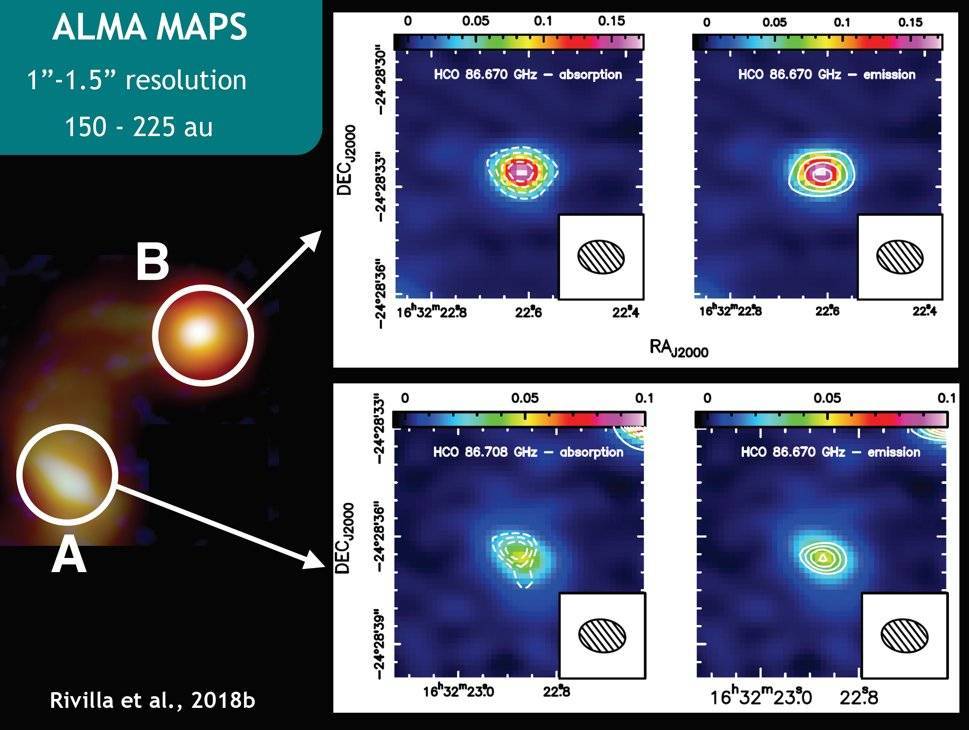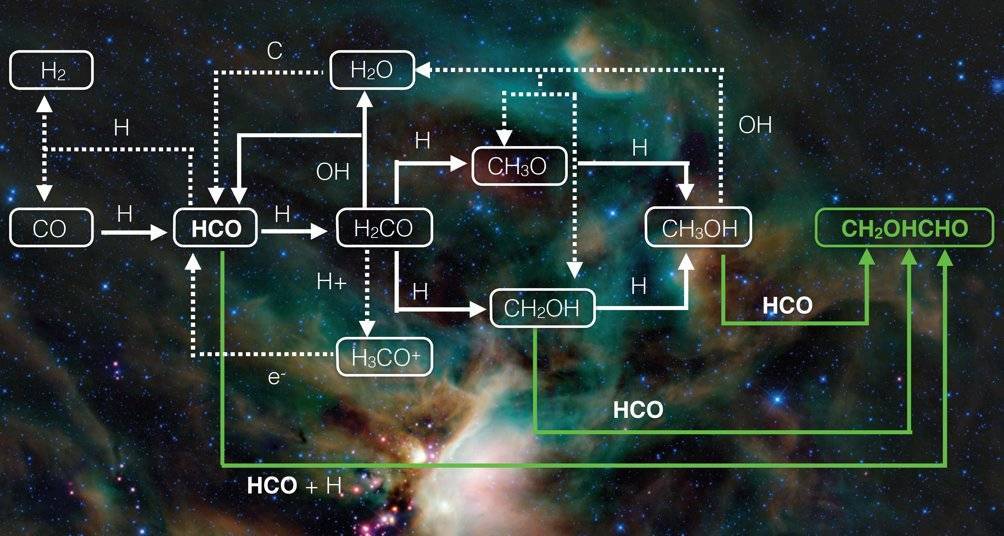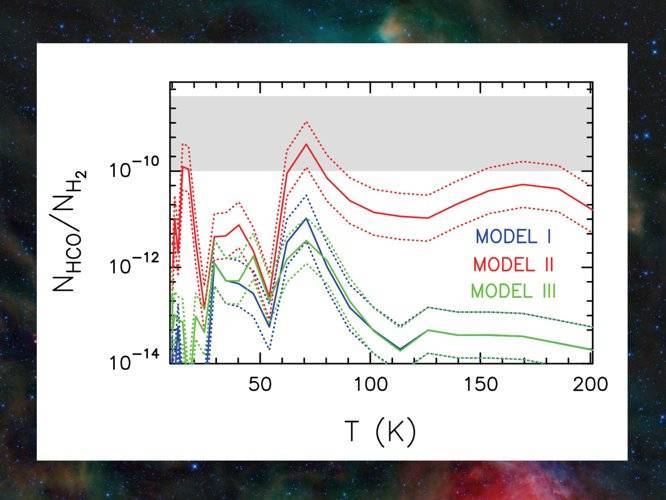Complex starts with simple:
First ALMA maps of HCO, an important precursor of complex organic molecules, towards IRAS 16293-2422
An international group of scientists from the Arcetri Astrophysical Observatory (INAF-OAA, Florence, Italy), the Ural Federal University (Russia), the Max-Planck Institute for Extraterrestrial Physics (MPE, Garching, Germany) and the University College of London (UK) has obtained for the first time maps of the emission of the formyl radical, HCO, towards a Solar-type protostellar binary. This simple molecule is the basic precursor of more complex organic molecules related to the origin of Life.
The formation of complex organic molecules (COMs) − carbon-based compounds with more than 5 atoms - is being intensively debated in astrochemistry. COMs play a central role in prebiotic chemistry and are thought to be directly linked to the origin of life. Numerous efforts have been done in the last years to understand how COMs are formed in the interstellar medium (ISM), by combining observations, chemical models and laboratory experiments. However, despite all efforts, our understanding about the synthesis of COMs in the ISM is still very limited. Two paradigms have been proposed: i) gas-phase chemistry triggered by the evaporation (thermal or non-thermal) of interstellar ices; and ii) hydrogenation and/or radical-radical reactions on dust grain surfaces.
A key step to understand how complex molecules are built up in the ISM is to study their molecular precursors, namely, the basic pieces that lead to their formation. Many chemical models and laboratory experiments have suggested that the simple formyl radical, HCO, is the precursor of COMs like e.g. methanol, the sugar-like molecule glycolaldehyde, the sugar-alcohol ethylene glycol, or formamide. However, despite the importance of HCO to build-up chemical complexity, little is known so far about its formation.
To better understand the role of HCO in the formation of COMs, an international group of astronomers have studied this molecule towards the Solar-type protostellar binary IRAS 16293−2422 using the Atacama Large Millimeter/submillimeter Array (ALMA). The work is led by the Marie Skłodowska-Curie fellow Víctor M. Rivilla, and includes also the participation of Maite Beltrán, Francesco Fontani and Riccardo Cesaroni (INAF-Arcetri Astrophysical observatory). The high angular resolution (∼1′′, ∼150 au) maps reveal compact HCO emission arising from the two protostars (see Figure 1). The line profiles also show redshifted absorption produced by foreground material of a circumbinary envelope that is infalling towards the protostars. Additionally, IRAM 30m single-dish data revealed a more extended HCO component arising from the common circumbinary envelope.

Fig. 1: ALMA maps of the HCO emission and absorption towards the two members, A and B, of the Solar-type protostellar binary IRAS 16293−2422.
The comparison between the observed molecular abundances and the chemical model (see Figure 2) suggests that whereas the extended HCO from the envelope can be formed via gas-phase reactions during the cold collapse of the natal core, the HCO in the hot corinos surrounding the protostars is predominantly formed by the hydrogenation of CO on the surface of dust grains and subsequent thermal desorption during the protostellar phase (see Figure 3). The derived abundance of HCO in the dust grains is high enough to produce efficiently more complex species such as formaldehyde (H2CO), methanol (CH3OH), and glycolaldehyde (CH2OHCHO) by surface chemistry

Fig. 2: Chemical routes discussed in the article and implemented in the chemical model to study the formation and HCO (in white) and glycoladehyde, CH2OHCHO (in green). The solid and dashed arrows indicate gas-phase and grain surface reactions, respectively.

Fig. 3: Results of the different chemical models (I, II and III) developed to investigate the formation of HCO during the warm-up phase of a protostar. The evolution of the molecular abundance of HCO is represented as a function of temperature. The area within the dotted curves delimit the uncertainty of the chemical model. Model I (blue) includes only gas-phase reactions; model II (red) includes gas-phase reactions and the surface hydrogenation of CO; and model III (green) includes gas-phase reactions and the surface reaction H2CO + OH → HCO + H2CO. The horizontal light gray band indicates the range of HCO abundances found in the ALMA observations.
Publication: First ALMA maps of HCO, an important precursor of complex organic molecules, towards IRAS 16293-2422, V. M. Rivilla, M. T. Beltrán, A. Vasyunin, P. Caselli, S. Viti, F. Fontani, R. Cesaroni, article accepted in Monthly Notices of the Royal Astronomical Society, in press, arXiv:1811.01650, https://arxiv.org/abs/1811.01650
Contact:
Víctor M. Rivilla Rodríguez
Marie Sklodowska-Curie ASTROFIT2 Fellow
Osservatorio Astrofisico di Arcetri, Florence, Italy
Website: http://www.arcetri.astro.it/~rivilla/
e-mail: Questo indirizzo email è protetto dagli spambots. È necessario abilitare JavaScript per vederlo.
Acknowledgments: This project has received funding from the European Union’s Horizon 2020 research and innovation programme under the Marie Skłodowska-Curie grant agreement No 664931



